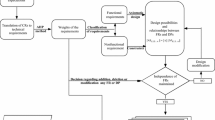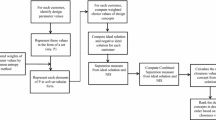Abstract
Concept design evaluation is the most critical part of product design, which determines the direction of the subsequent design stage. Due to the various uncertainties inherent in decision-maker (DM)’s linguistic evaluation, such as fuzziness and randomness, how to deal with these uncertainties reasonably is a challenge. Only using a single uncertainty treatment method may not be enough to select an appropriate conceptual design. Therefore, this paper aims to develop an extended information axiom concept design evaluation model combining linguistic Z-numbers (LZNs) and axiomatic design methods to deal with the uncertainty in concept design evaluation. Specifically, the LZNs are used to express DM's subjective evaluation information and the reliability of the evaluation result. In the evaluation process, the uncertainty caused by linguistic variables is represented by the cloud model. Moreover, the compatibility weights of concepts are derived objectively based on the compatibility matrix. Finally, the design combination with the minimum information content is obtained by using the extended information axiom. The feasibility and applicability of this method are verified by an evaluation example of ink pen concept design. Compared with the existing methods, the proposed method considers more uncertainty and is more in line with the actual situation.






Similar content being viewed by others
References
Fathianathan M, Panchal JH (2009) Incorporating design outsourcing decisions within the design of collaborative design processes. Comput Ind 60(6):392–402. https://doi.org/10.1016/j.compind.2009.02.010
Krishnapillai R, Zeid A (2006) Mapping product design specification for mass customization. J Intell Manuf 17(1):29–43. https://doi.org/10.1007/s10845-005-5511-3
French MJ, Gravdahl JT, French MJ (1985) Conceptual design for engineers. Design Council, London
Hague MJ, Taleb-Bendiab A (1998) Tool for the management of concurrent conceptual engineering design. Concurr Eng 6(2):111–129. https://doi.org/10.1177/1063293X9800600203
Pahl G, Beitz W (2013) Engineering design: a systematic approach. Springer, Berlin
Wang L, Shen W, Xie H, Neelamkavil J, Pardasani A (2002) Collaborative conceptual design—state of the art and future trends. Comput Aided Des 34(13):981–996. https://doi.org/10.1016/S0010-4485(01)00157-9
Zadeh LA (1978) Fuzzy sets as a basis for a theory of possibility. Fuzzy Sets Syst 1(1):3–28. https://doi.org/10.1016/0165-0114(78)90029-5
Pai GV (2016) Fuzzy decision theory based metaheuristic portfolio optimization and active rebalancing using interval type-2 fuzzy sets. IEEE Trans Fuzzy Syst 25(2):377–391. https://doi.org/10.1109/TFUZZ.2016.2633972
Wang J, Wang JQ, Tian ZP, Zhao DY (2018) A multihesitant fuzzy linguistic multicriteria decision-making approach for logistics outsourcing with incomplete weight information. Int Trans Oper Res 25(3):831–856. https://doi.org/10.1111/itor.12448
Wang JQ, Wu JT, Wang J, Zhang HY, Chen XH (2014) Interval-valued hesitant fuzzy linguistic sets and their applications in multi-criteria decision-making problems. Inf Sci 288:55–72. https://doi.org/10.1016/j.ins.2014.07.034
Li D, Liu C, Gan W (2009) A new cognitive model: cloud model. Int J Intell Syst 24(3):357–375. https://doi.org/10.1002/int.20340
Xiao L, Huang G, Zhang G (2021) Improved assessment model for candidate design schemes with an interval rough integrated cloud model under uncertain group environment. Eng Appl Artif Intell 104:104352. https://doi.org/10.1016/j.engappai.2021.104352
Tan C, Wu DD, Ma B (2011) Group decision making with linguistic preference relations with application to supplier selection. Expert Syst Appl 38(12):14382–14389. https://doi.org/10.1016/j.eswa.2011.04.036
Zadeh LA (2011) A note on Z-numbers. Inf Sci 181(14):2923–2932. https://doi.org/10.1016/j.ins.2011.02.022
Kuo JY, Chen CH, Koyama S, Chang D (2021) Investigating the relationship between users’ eye movements and perceived product attributes in design concept evaluation. Appl Ergon 94:103393. https://doi.org/10.1016/j.apergo.2021.103393
Akay D, Kulak O, Henson B (2011) Conceptual design evaluation using interval type-2 fuzzy information axiom. Comput Ind 62(2):138–146. https://doi.org/10.1016/j.compind.2010.10.007
Prasad S, Khanduja D, Sharma SK (2018) Integration of SWOT analysis with hybrid modified TOPSIS for the lean strategy evaluation. Proc Inst Mech Eng Part B J Eng Manuf 232(7):1295–1309. https://doi.org/10.1177/0954405416666893
Rondini A, Bertoni M, Pezzotta G (2017) An IPA based method for PSS design concept assessment. Procedia CIRP 64:277–282. https://doi.org/10.1016/j.procir.2017.03.061
Lu MT, Hsu CC, Liou JJ, Lo HW (2018) A hybrid MCDM and sustainability-balanced scorecard model to establish sustainable performance evaluation for international airports. J Air Transp Manag 71:9–19. https://doi.org/10.1016/j.jairtraman.2018.05.008
Sedghiyan D, Ashouri A, Maftouni N, Xiong Q, Rezaee E, Sadeghi S (2021) Prioritization of renewable energy resources in five climate zones in Iran using AHP, hybrid AHP-TOPSIS and AHP-SAW methods. Sustain Energy Technol Assess 44:101045. https://doi.org/10.1016/j.seta.2021.101045
Jeong HY (2020) ANP-based quantification method for the smart manufacturing system design decomposition. J Supercomput 76(8):6141–6157. https://doi.org/10.1007/s11227-018-2665-2
Tiwari RK, Kumar R (2021) G-TOPSIS: a cloud service selection framework using Gaussian TOPSIS for rank reversal problem. J Supercomput 77(1):523–562. https://doi.org/10.1007/s11227-020-03284-0
Singh RK, Modgil S (2020) Supplier selection using SWARA and WASPAS—a case study of Indian cement industry. Meas Bus Excell. https://doi.org/10.1108/MBE-07-2018-0041
Shaverdi M, Ramezani I, Tahmasebi R, Rostamy AAA (2016) Combining fuzzy AHP and fuzzy TOPSIS with financial ratios to design a novel performance evaluation model. Int J Fuzzy Syst 18(2):248–262. https://doi.org/10.1007/s40815-016-0142-8
Abdel-Baset M, Chang V, Gamal A, Smarandache F (2019) An integrated neutrosophic ANP and VIKOR method for achieving sustainable supplier selection: a case study in importing field. Comput Ind 106:94–110. https://doi.org/10.1016/j.compind.2018.12.017
Goswami M, Daultani Y, De A (2021) Decision modeling and analysis in new product development considering supply chain uncertainties: a multi-functional expert based approach. Expert Syst Appl 166:114016. https://doi.org/10.1016/j.eswa.2020.114016
Aliev RA, Zeinalova LM (2014) Decision making under Z-information//human-centric decision-making models for social sciences. Springer, Berlin, pp 233–252
Liu Q, Chen J, Wang W, Qin Q (2021) Conceptual design evaluation considering confidence based on Z-AHP-TOPSIS method. Appl Sci 11(16):7400. https://doi.org/10.3390/app11167400
Hendiani S, Bagherpour M, Mahmoudi A, Liao H (2020) Z-number based earned value management (ZEVM): a novel pragmatic contribution towards a possibilistic cost-duration assessment. Comput Ind Eng 143:106430. https://doi.org/10.1016/j.cie.2020.106430
Ghahtarani A (2021) A new portfolio selection problem in bubble condition under uncertainty: application of Z-number theory and fuzzy neural network. Expert Syst Appl 177:114944. https://doi.org/10.1016/j.eswa.2021.114944
Wang JQ, Cao YX, Zhang HY (2017) Multi-criteria decision-making method based on distance measure and Choquet integral for linguistic Z-numbers. Cogn Comput 9(6):827–842. https://doi.org/10.1007/s12559-017-9493-1
Peng HG, Wang JQ (2017) Hesitant uncertain linguistic Z-numbers and their application in multi-criteria group decision-making problems. Int J Fuzzy Syst 19(5):1300–1316. https://doi.org/10.1007/s40815-016-0257-y
Huang W, Zhang Y, Yin D, Zuo B, Xu M, Zhang R (2021) Using improved Group 2 and Linguistic Z-numbers combined approach to analyze the causes of railway passenger train derailment accident. Inf Sci 576:694–707. https://doi.org/10.1016/j.ins.2021.07.067
Li L, Fan F, Ma L, Tang Z (2016) Energy utilization evaluation of carbon performance in public projects by FAHP and cloud model. Sustainability 8(7):630. https://doi.org/10.3390/su8070630
Wang XK, Wang SH, Zhang HY, Wang JQ, Li L (2021) The recommendation method for hotel selection under traveller preference characteristics: a cloud-based multi-criteria group decision support model. Group Decis Negot. https://doi.org/10.1007/s10726-021-09735-0
Peng HG, Zhang HY, Wang JQ (2018) Cloud decision support model for selecting hotels on TripAdvisor.com with probabilistic linguistic information. Int J Hosp Manag 68:124–138. https://doi.org/10.1016/j.ijhm.2017.10.001
Karatas M (2020) Hydrogen energy storage method selection using fuzzy axiomatic design and analytic hierarchy process. Int J Hydrogen Energy 45(32):16227–16238. https://doi.org/10.1016/j.ijhydene.2019.11.130
Aydoğan S, Günay EE, Akay D, Kremer GEO (2020) Concept design evaluation by using Z-axiomatic design. Comput Ind 122:103278. https://doi.org/10.1016/j.compind.2020.103278
Kumar P, Tandon P (2019) A paradigm for customer-driven product design approach using extended axiomatic design. J Intell Manuf 30(2):589–603. https://doi.org/10.1007/s10845-016-1266-2
Akay H, Kim SG (2020) Design transcription: deep learning based design feature representation. CIRP Ann 69(1):141–144. https://doi.org/10.1016/j.cirp.2020.04.084
Liu Z, Chu X, Ma H, Zhang M (2021) Prioritizing failure risks of components based on information axiom for product redesign considering fuzzy and random uncertainties. Concurr Eng. https://doi.org/10.1177/1063293X211015999
Maghsoodi AI, Mosavat M, Hafezalkotob A, Hafezalkotob A (2019) Hybrid hierarchical fuzzy group decision-making based on information axioms and BWM: prototype design selection. Comput Ind Eng 127:788–804. https://doi.org/10.1016/j.cie.2018.11.018
Kahneman D, Tversky A (2013) Prospect theory: an analysis of decision under risk. In: Leonard CM, William TZ (eds) Handbook of the fundamentals of financial decision making: Part I, pp 99–127. https://doi.org/10.1142/9789814417358_0006
Song C, Wang JQ, Li JB (2020) New framework for quality function deployment using linguistic Z-numbers. Mathematics 8(2):224. https://doi.org/10.3390/math8020224
Suh NP (1998) Axiomatic design theory for systems. Res Eng Des 10(4):189–209. https://doi.org/10.1007/s001639870001
Peng HG, Wang JQ (2018) A multicriteria group decision-making method based on the normal cloud model with Zadeh’s Z-numbers. IEEE Trans Fuzzy Syst 26(6):3246–3260. https://doi.org/10.1109/TFUZZ.2018.2816909
Tauhid S, Okudan G (2007) Fuzzy information axiom approach for design concept evaluation. In: DS 42: proceedings of ICED 2007, the 16th international conference on engineering design, Paris, France, 28.-31.07. 2007, pp 37–38
Heinen A, Valdesogo A (2020) Spearman rank correlation of the bivariate Student t and scale mixtures of normal distributions. J Multivar Anal 179:104650. https://doi.org/10.1016/j.jmva.2020.104650
Acknowledgements
This research was funded by the Youth Science and Technology Talent Growth Project by the Department of Education of Guizhou Province (Grant numbers: KY [2017]106 and KY [2018]112), the Science and Technology Foundation of Guizhou Province (Grant number: [2020]1Y262 and [2020]1Y232) and Guizhou University Talent Fund (Grant numbers: 2019-07).
Author information
Authors and Affiliations
Contributions
Qinghua Liu was involved in conceptualization, methodology, validation, formal analysis, writing—original draft, writing—review and editing. Jiadui Chen contributed to conceptualization, writing—review and editing, project administration, supervision, funding acquisition. Yongming Wu was involved in investigation, formal analysis, writing—review and editing. Kai Yang contributed to writing—review and editing, funding acquisition, formal analysis.
Corresponding author
Ethics declarations
Conflict of interest
The authors declare that they have no known competing financial interests or personal relationships that could have appeared to influence the work reported in this paper.
Additional information
Publisher's Note
Springer Nature remains neutral with regard to jurisdictional claims in published maps and institutional affiliations.
Rights and permissions
About this article
Cite this article
Liu, Q., Chen, J., Wu, Y. et al. Linguistic Z-numbers and cloud model weighted ranking technology and its application in concept evaluation of information axiom. J Supercomput 78, 6061–6089 (2022). https://doi.org/10.1007/s11227-021-04106-7
Accepted:
Published:
Issue Date:
DOI: https://doi.org/10.1007/s11227-021-04106-7




